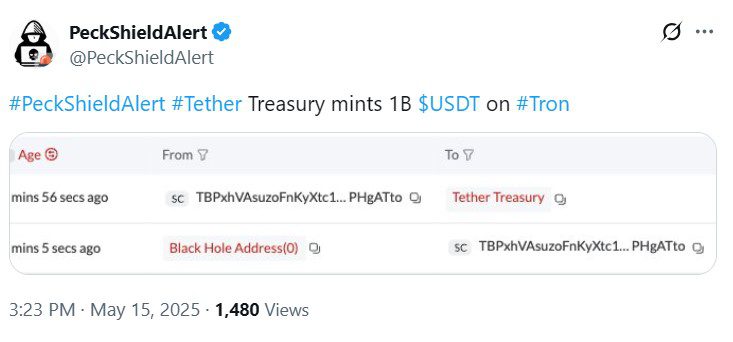The stablecoin landscape is constantly evolving, and a recent development has put Tron back in the spotlight. Tether, the issuer of USDT, minted an additional 1 billion USDT tokens on the Tron network, potentially shifting the balance of power in the stablecoin market. This move has significant implications for both Tron and Ethereum, the two leading blockchains for USDT circulation.
Tron vs. Ethereum: A USDT Showdown
As of May 14, data indicated that Tron’s authorized USDT supply totaled $73.7 billion, slightly trailing Ethereum’s $74.5 billion. However, with the addition of the newly minted $1 billion, Tron’s total authorized USDT supply now surpasses that of Ethereum. This marks a significant shift, as Ethereum has been a dominant player in the USDT market for some time.
Furthermore, Tron also leads in circulating USDT supply, with $73.6 billion on the network compared to Ethereum’s $71.8 billion. This indicates that more USDT is actively being used on the Tron blockchain, suggesting greater adoption and utility within its ecosystem.
Key Takeaways:
- Tron’s authorized USDT supply now exceeds Ethereum’s after a $1 billion mint.
- Tron also leads in circulating USDT supply, indicating higher usage.

Why Does This Matter?
The distribution of USDT supply across different blockchains has several important implications:
- Network Activity: A larger USDT supply can indicate higher levels of activity on a blockchain, as it suggests more users are utilizing USDT for transactions, trading, and other purposes.
- Liquidity: Greater USDT liquidity can make it easier for users to buy and sell cryptocurrencies on a particular blockchain, potentially attracting more traders and investors.
- Ecosystem Growth: A thriving USDT ecosystem can foster the growth of decentralized applications (dApps) and other projects on a blockchain, as it provides a stable and reliable medium of exchange.
Tether’s USDT Minting Strategy
Tether CEO Paolo Ardoino has explained that the company periodically mints USDT to replenish its inventory on various blockchain networks. These tokens are then used to fulfill issuance requests and facilitate chain swaps, ensuring that Tether can meet the demands of its users.
Think of it like a traditional business maintaining its stock levels. Tether mints USDT in anticipation of future demand, holding these tokens in reserve until they are needed. This proactive approach helps ensure smooth liquidity management and prevents potential disruptions to the USDT ecosystem.
The Broader Stablecoin Market
While Tron and Ethereum are the leading players in USDT circulation, other blockchains also host significant amounts of the stablecoin. Solana, for example, has the third-largest USDT supply, followed by Avalanche. These networks offer alternative options for users who want to utilize USDT in different ecosystems.
The overall stablecoin market is dominated by Tether, which accounts for a significant share of all USD-pegged stablecoins in circulation. Circle, the issuer of USDC, is Tether’s closest competitor, but it still lags behind in terms of market share. The dominance of USDT highlights its importance as a key component of the cryptocurrency ecosystem.
CoinGecko data shows that Tether’s total circulation is at a record high of $150 billion, a 9.4% increase over its supply at the start of 2025. This gives the stablecoin issuer 61% of all the USD stablecoins in the market. Circle, its closest competitor, has $60.4 billion in stablecoins, giving it a market share of 24.6%, according to CoinGecko.
USDT Supply by Network:
- Tron: $73.7 billion (authorized)
- Ethereum: $74.5 billion (authorized before the Tron mint)
- Solana: $2.3 billion (authorized)
- Avalanche: $1.8 billion (authorized)
Conclusion
Tron’s recent surge in USDT supply highlights the ongoing competition in the stablecoin market. While Ethereum has long been a dominant force, Tron’s growing ecosystem and strategic minting practices have allowed it to regain the lead. As the stablecoin landscape continues to evolve, it will be interesting to see how these networks adapt and compete for market share. This battle for USDT dominance underscores the importance of stablecoins in the broader cryptocurrency market and their role in facilitating transactions, trading, and the growth of decentralized finance (DeFi).